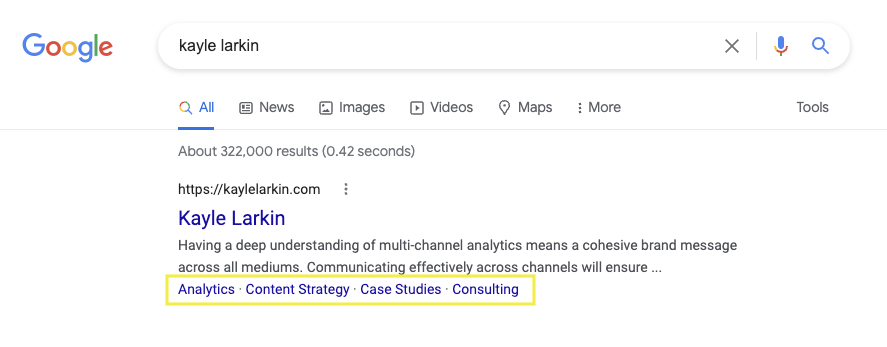If only we had full control over our website’s appearance in Google Search properties.
Sadly, that’s not the case, as someone discovered recently.
Today’s Ask An SEO question comes from Marwan from England, who asks:
“How do I remove transactional landing pages such as “Restaurant branding agency” off my Google organic sitelinks and instead have main pages of my website such as ”about” ”services” “contact”, and blog?
I have implemented all the instructions to influence sitelinks, but I haven’t managed to change them so far.”
Organic Sitelinks Defined
Google is trying to make it easy for people to find what they’re searching for.
One of the ways Google does this is by displaying organic sitelinks.
Organic sitelinks are four links displayed under the primary organic listing that go to other pages on your site, or jump directly to content within pages using fragment (#) links.
Here’s an example:
 Screenshot from search for [kayle larkin], July 2022
Screenshot from search for [kayle larkin], July 2022By analyzing the link structure on our website, Google can present our content, so people don’t have to dig as much.
But what happens when Google chooses content such as a transactional landing page that we don’t want front and center?
Is there anything you can do?
How To Remove Unwanted Sitelinks
Google automates sitelinks.
Site owners and web admins cannot directly demote or remove an unwanted sitelink.
As of February 28, 2022, Google hints that it may incorporate site owner input in the future.
Marwan notes that they have implemented all the instructions to influence sitelinks with no success.
As we don’t know which changes were implemented, it bears repeating.
Here are four best practices, supported by Google, that may influence your sitelinks.
1. Page Titles Are Informative And Compact
While “Services” is compact, it is not as informative to the Google search user as “Restaurant branding agency.”
This may explain why the transactional landing pages are being pulled over the website’s main pages.
What if “Services” became “Branding Services?”
2. Site Structure Is Logical With Meaningful Categories
We don’t know the structure of this website and how it links to relevant pages within, but we know that Google places great emphasis on site structure.
Google Search Central documentation explains that it looks at the structure of your site (how your pages are linked together) to find shortcuts that will help users quickly find the answer to their query.
Are you interested in learning more about site structure and internal linking for SEO?
Jesse McDonald, Global SEO strategist at IBM, wrote an in-depth article to help you establish a strong SEO foundation.
3. Anchor Text Is Short And To The Point
Anchor text is the visible, clickable text of a link.
Mindy Weinstein, SEJ author and Founder at Market Mindshift, shares how she removes unwanted sitelinks in the steps below.
Crawl your website to find all internal links to the page you wish to remove (“Restaurant branding agency”).
Review this list and update the anchor text of internal links going to the unwanted sitelink.
Resubmit in Search Console, wait for crawling, and recheck your search listing.
4. In Case Of Emergency: Add Noindex Or Remove The Page
The last tip should only be used if the landing page is no longer in use.
Noindex or remove the page from your website.
Doing so will effectively remove the organic sitelink, because it removes the page from Google’s index.
Final Thoughts
While there is no direct control that allows website owners to select or remove sitelinks, we can use the information above to influence which sitelinks show in Google’s search results.
More resources:
Featured Image: Ribkhan/Shutterstock
Editor’s note: Ask an SEO is a weekly SEO advice column written by some of the industry’s top SEO experts, who have been hand-picked by Search Engine Journal. Got a question about SEO? Fill out our form. You might see your answer in the next #AskanSEO post!
